Guyana Focus

(First of 3 parts)
Nineteen years after the PPP/Civic government came to power on October 5th 1992, the government is mired in a wave of deserved and often undeserved criticisms. Evidently, the euphoria of having the first democratically elected government in almost two decades has completely subsided as Guyanese struggle to deal with economic, political and social uncertainty, high levels of crime and pervasive corruption. As seemingly reinforced opposition forces seek to attain power in the upcoming general elections expected to be held in November, criticisms of the government's performance have intensified – though mostly baseless.
Arguably, Guyana has made tremendous strides over the past 19 years under the PPP/C government but the government's achievements have been often overshadowed by consistent, sometimes undeserved criticisms and censure by opposition forces, various interest groups, and as Guyanese would put it, "sour grapes", whose objectives are in most cases underpinned by self-interest and in certain instances, the desire to spur racial divisions.
There is no doubt that the government has many shortcomings and weaknesses, among them the inability to control corruption, poor governance and administration, and the lack of transparency. These limitations provide impetus for forces opposed to the government to create a perception of worsening rather than improving conditions in Guyana.
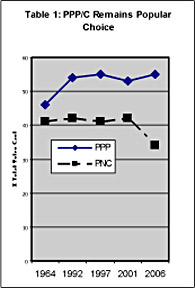
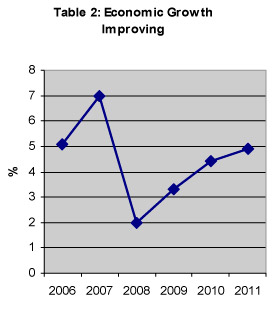
To make matters worse for opposing forces, the PPP/C has in recent years behaved more like a democratically elected government which has been given the power to run the country. But such power has often corrupted those who wield it, antagonizing opposing forces.
This stance has alienated opposition forces which believes the government should bend over backwards to meet their demands and expectations. To add salt to the wounds of the opposition, the PPP/C has not been as amenable, as it had been in the past, to fruitless "dialogues" and "open consultations" on matters of national interest, creating even further disgruntlements.
Incidentally, during the late 1990s–early 2000 period, the PPP/C consistently demonstrated that it was incapable of exercising its mandate to govern the country, with the dialogue process involving the People's National Congress/Reform (PNC/R) consuming much of its time. However, somehow the country's President, Bharrat Jagdeo grew up to accept his role – so much so that he is now regarded in some circles as "a power of one".
In spite of opposition challenges and waves of crime during its term in office, the only real concern for the ruling party has been the intent of certain political parties and interest groups to stir racial strife which has periodically put the country at crossroads. In fact, throughout its history racial flare-ups have been one of the major deterrents to Guyana's development. It has created fear; supported crime; spurred mass migration; distracted foreign investors; and subdued the development of local businesses.
Following the PPP/C's victory at the 1997 general elections, racial strife heightened, fuelled by the actions of the PNC/R which threatened to make the country ungovernable. However, the race issue has been silent after the leader of the PNC/R Desmond Hoyte died but is beginning to rear its ugly head once again, albeit more subtly.
From an economic standpoint, the PPP/C can be credited for putting the brakes on further deterioration of the Guyanese economy, although some credit must be given to the PNC/R administration under the late Desmond Hoyte for initiating the process with the IMF, backed by Canada which led the country out of the IMF's infamous debt trap. Arguably, growth during the Hoyte administration was tempered by the fact that the economy was coming off a historic period of relatively low growth.
During the first five year of the PPP/C's term in office, Guyana's economic growth averaged over 6% per year, but slumped in the following five year period to an average of just about 1%. Since 2006, growth has picked up appreciably to a rate of over 4% per annum (See Table 2), indicating signs of strong recovery.
In an IMF Staff Report published earlier this year, the international financial institution claimed that Guyana has sustained a solid economic performance in recent years, supported by a strengthened policy framework. It suggests that while Guyana has been adversely affected by the global crisis, it has weathered it significantly better than its Caribbean peers—and policy indicators have strengthened relative to regional standards.
Strong economic growth under the late President Cheddi Jagan's administration occurred in an environment of relative stability. Growth stemmed from increased domestic output, particularly in sugar, rice and gold, supported by a buoyant global economy.
Arguably, economic resurgence which commenced a few years prior to the PPP/C attaining power resulted mainly from leveraging capacity underutilization in the traditional sectors, and not necessarily from new development initiatives. When the PPP/C attained power, new leadership under the first democratically elected government in almost three decades contributed to renewed enthusiasm about Guyana's potential, creating a positive environment for growth.
However, the death of Cheddi Jagan in 1997 sent the country into political turmoil, which became a disincentive to investors and businesses. The lack of support for the late President Janet Jagan who succeeded her husband for a short period, and the utter disrespect for current President Bharrat Jagdeo in his early years, heightened political uncertainty, translating into an unstable environment.
As a result, growth in key productive sectors either declined or remained relatively flat, causing the economy to contract over the next five years. Poor economic conditions were exacerbated by a slump in the global economy, weakened commodity prices and unfriendly weather conditions.
In addition, political unrest initiated by the opposition PNC/R whose leader, the late Desmond Hoyte, threatened to make the country ungovernable, combined with a dramatic increase in crime caused the government to lose focus on development issues, resulting in a reversal of much of the gains made under the Cheddi Jagan administration.
All in all, from an economic standpoint the PPP/C has laid the groundwork for a strong economy, supported by relatively strong growth in recent years. Political squabbling has however prevented the country from flourishing. Part of the blame lies squarely on forces opposed to the administration – which are more concerned with attaining power than the country's future.
at Annandale
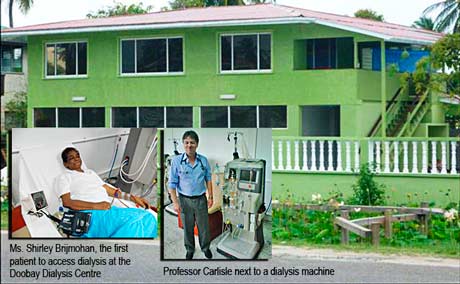
Georgetown — The Doobay Renal Centre located at Annandale, East Coast Demerara, was officially declared open last Wednesday with Ms. Shirley Brijmohan, the first patient to access dialysis on the opening day of the facility.
The centre aims to offer dialysis treatment at an affordable cost to Guyanese.
Professor Carlaisle from McMaster University in Canada, who was part of the team setting up the facility, outlined that dialysis is a life-saving therapy for people with renal problems, but it can also be a very expensive procedure which many people cannot afford. Noting that kidney failure is a disease that strikes all ages – young and old, he said that, without dialysis, people with kidney failure would eventually die.
"With the opening of the Doobay Dialysis Centre, Guyanese can be assured of access to dialysis which is both affordable and also of the highest quality, meeting all international standards," he said.
Dr Surendra Persaud, a registered surgeon and one of the partners in this project, told Kaieteur News that the centre is a registered 'not for profit' body which is working in collaboration with the Government of Guyana, the Ministry of Health and with major support from Canada-based Guyanese.
Dr Persaud said that Dr. Budhendra Doobay, who has worked with the Georgetown Public Hospital Corporation and who is a Cardiovascular Surgeon in Canada, has worked assiduously with Vic Oditt to make it a reality. He added that help was received from two Canada-based universities, and from Canada-based Guyanese. Kaieteur News (KN) reported that almost everything at the centre which includes machines was donated.
Dr Persaud also disclosed that the centre has also donated three machines to the Georgetown Public Hospital and is working towards donating the water system.
He pointed out that Georgetown would be the primary center, taking care of only the acute patients while the Doobay Centre would be taking care only of the chronic patients. Dr Persaud stated that an on-call physician from the Georgetown Public Hospital would be stationed at the Center.
The treatment per patient per session would cost some $15,000. It was explained that even if persons do not have that full price, they would not be turned away.
Retired nurse Canada-based Jamaican Louisa McKenzie was flown in to train nurses from Guyana and has already trained 14 nurses, with four of them having knowledge of Hemodialysis.
Minister of Health Dr Leslie Ramsammy disclosed that a dialysis center at the Georgetown Hospital is expected to open sometime this week. He stated that Government had spent some $10M for the support of people getting dialysis treatment, last year.
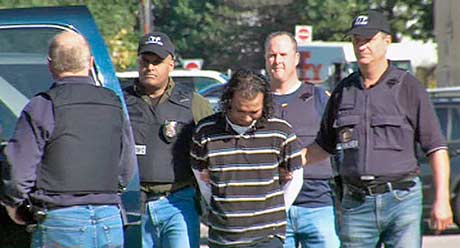
Georgetown — The Royal Canadian Mounted Police (RCMP), acting on a tip, nabbed Shameer Allie, a 36-year-old Guyanese national whose name was on the most wanted list of criminals. Allie, who was convicted of violence and weapons related crimes in Toronto, was arrested in the Dixon Road and Kipling Avenue in Toronto at approximately 6:00 am last Thursday morning without incident.
His arrest followed a tip submitted on the Canada Border Services Agency (CBSA)'s website.
He was wanted on a Canada-wide warrant for removal from the country. The CBSA has already initiated proceedings to have him deported.
Allie's name was posted on a recently released (Aug. 18) most-wanted list, which featured the names and photos of foreign fugitives hiding in Canada. The list is a selection of men among a group of 1,400 dangerous criminals without immigration status who are hiding in Canada.
The CBSA published the names of 32 fugitives to its most-wanted website, to encourage Canadians who recognize the individuals to turn them in. Those names followed the original list of 30 individuals first published in July.
The website states, "It has been determined that they violated human or international rights under the Crimes Against Humanity and War Crimes Act or under international law."
So far tips submitted to the website have led border officials to locate 16 wanted fugitives.

With the original deadline of September 9 already passed, the extension to the deadline stemmed from a decision to make the road wider, Senior Engineer of the Ministry of Public Works, Walter Willis, disclosed.
Updating reporters on the works which is critical to close financing of the Amaila Falls hydro-project, Willis also disclosed that Synergy Holdings has only been paid US$2.9M for works completed and was being managed closely, Kaieteur News (KN) reported.
Synergy Holding's principal, Makeshwar 'Fip' Motilall, has been under the spotlight since being handed the multi-million dollar contract, with questions being raised about his road building experience.
The work on the hydro road includes the upgrade of approximately 85 kilometres of existing roadway and the design and construction of approximately 110 kilometres of new roads leading to Amaila Falls, located up the Potaro River, Essequibo.
Among the 15 bridges Synergy also has to build, one was a 240 feet bridge across the Kuribrong River, also located in the Potaro area. Synergy has asked for permission to use aquapanels to construct that bridge and this proposal is being studied by the Ministry of Public Works, Willis said.
A pontoon for the Butakari crossing has already been shipped from EC Vieira Shipworks to the Omai wharf with the landing for Butakari to be built soon.
It will be recalled that Synergy was issued permission to proceed on October 5, 2010.
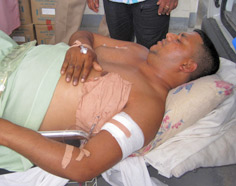
Rooney is claiming damages and compensation for trespass, assault and battery to the person. In the order, Police Inspector Cumberbatch of the Guyana Police Force is said to have shot Rooney with a firearm at Number Two village East Canje Berbice resulting in injuries, losses and damage to his person.
On the day in question Rooney was at home when a car driven by gas station owner, Bangat, with Cumberbatch inside pulled up in front of his house. The men allegedly accosted Rooney and demanded that he enter the car but when he refused he was shot by Cumberbatch. Rooney was seriously injured and was hospitalized.
According to Bacchus at the time Rooney did not know who Cumberbatch was. Police from New Amsterdam subsequently arrived and took Cumberbatch and others into custody.
At the time it was alleged that Cumberbatch was working as an enforcer for gas station owner Bangat of the EC Demerara.
The allegations were that Rooney, who once worked at the gas station, had stolen some money from the gas station owner.
Meanwhile Attorney-at-Law Mursaline Bacchus has also filed a $5M lawsuit in the High Court against the Attorney General (AG) and the Guyana Police Force on behalf of another client, Rawle Carter, seeking redress for wrongful arrest and imprisonment by members of the Joint Services.
The 18-year-old Carter who was locked up at the Central Police Station by ranks of the Joint Services for over 18 hours, reportedly without being given food, water or even allowed a phone call, is seeking redress through the High Court.
The young man, who his attorney claims has never been involved in any brushes with the law, and some others were picked up by a Joint Services patrol on the evening of Sunday June 19, whilst on their way home. He was reportedly on his bicycle and claims to have been dumped into a police pickup and subsequently thrown into the lock ups. His lawyer said the teen was never told why he was arrested until they were at the station, where they were informed that they had been arrested for rape. His request for a phone call was allegedly denied. He was sent home on June 20 and told to return on June 22 at which time he was told that the matter was finished. The officer apologized on behalf of the Guyana police force for the tardiness of the ranks on duty and for not allowing a phone call to be made.
campaign financing
The National Assembly had passed a resolution on April 28, 2011 to set up a Special Select Committee to examine the existing laws and regulations regarding political parties' electoral expenses, examine such legislation in other countries, and report their findings to the National Assembly. The report of the Special Select Committee on Campaign Financing was tabled in the National Assembly two weeks ago. The motion was taken to the House by Alliance for Change Parliamentarian Sheila Holder.
The Committee consisted of six Parliamentarians from the government side of the house; three Parliamentarians from the main opposition PNCR, and one member from the smaller opposition party, the AFC.
Georgetown — Five pirates, posing as seamen, carried out a brazen attack on eight fishing boats in the Corentyne River, in the vicinity of Caronie and Nickerie some time between 2:00 am and 3:00 am last Thursday. This was the 15th attack in the past month.
According to Chairman of the Berbice Fishermen's Co-operative Society, Indarpersaud Rampersaud, six boats from the Berbice Society and two from the Rosignol Fishermen's Co-operative Society were hijacked on the Suriname side of the Corentyne River in an area called 'Shell', during the attack. This latest attack affected over 35 fishermen some of them badly beaten in the process as the pirates carted away all of the day's catch as well as fish glue. While the pirates did not take any engine this time, they disconnected the engine leads from several of the boats setting the fishermen adrift.
The pirates huddled all the captains in one boat and set them drift while they made their escape. After the brutal attack some of the victims used their skills to get to shore on the Guyana side and report the incident. They also collected spare leads and other spare parts and headed back to sea to rescue their stranded colleagues.
Fishermen set ablaze, die
Georgetown — Two fishermen, who were allegedly doused with gasoline and set alight by another fisherman, have succumbed to their injuries.
According to reports Beeram Motee Lall, 45, of Bloomfield Village, Corentyne and Reynard Fernandes, 15, of Rose Hall Town, Corentyne, were fishing at around 9:00 pm on September 6 last, when another fisherman, known as "Kalla", threw gasoline on them and set them alight. The assailant was later arrested but it is unclear what triggered the attack. He is reported to be mentally unstable.
The victims reportedly jumped overboard to extinguish the flames but swam back on board. Lall then drove the boat to land where they were taken to hospital.
Motee Lall leaves to mourn his wife, Shivana and four children, Karran 14, Keeshan 12, Tasha 11, and Arvin, aged nine.
Renyaldo Fernandes had dropped out of school recently to assist his parents financially.
Georgetown — The entombed corpse of Rickie Ramkarran was discovered with its head missing and neatly placed back into its coffin a day after the funeral. The gruesome discovery was made by a family member who went to the Tuschen cemetery to do some finishing touches to the tomb when he noticed that the tomb was broken into.
Ramkarran, 24, of Tuschen, East Bank Essequibo, died on September 5 after ingesting poison. He was buried on September 8 last. His mother, Prampattie Persaud, believes that a Tuschen woman is involved in witchcraft and is responsible for the disappearance of her son's head. Prampattie told Kaieteur News (KN) that her family was reliably informed that the woman whom she suspects and who lives several houses away from them, buried the head in her backyard for purposes of witchcraft and will use the head to ensure the death of other family members.
The dead man's mother strongly believes that the woman utilized her 'powers' to invoke spirits onto Ramkarran causing him to commit suicide by drinking poison.
She recounted that a couple of days before her son ingested poison and died, the son of the woman suspected of witchcraft threatened Ramkarran that he only had 21 more days to live.
A Police search of the woman's property did not unearth anything but the dead man's mother insists that that she has knowledge of the whereabouts of the missing head.
Georgetown — Tessa Ramascindo, 35, a mother of six, of 'Rasta Town' in Laluni, off the Linden Soesdyke Highway, was allegedly hacked to death by her husband two Tuesdays ago.
The dead woman's body was discovered in her backyard by her 19-year-old daughter Monica Deonarine along with several other residents who traced blood from the front of the yard. According to reports, there were chop wounds about the woman's body. Her husband of 22 years, 45-year-old Seonarine Deonarine is suspected to have killed her.
Monica told Kaieteur News (KN) that her mother and father along with four of her siblings woke up and began their regular routine that morning. Monica said she normally assists her mother in getting her other siblings ages 8, 11, 13 and 14, ready for school and once they were all prepared for school her mother leaves the house. The eldest child is 23.
That morning Monica went to her aunt's and while there she received a call on her cellular from her father who told her that he just killed her mother and drank poison. Her father's body was discovered last Friday in a state of decomposition.
Georgetown — Ralph Turpin, 54, a drug rehabilitation counsellor, was shot twice in his head at point blank range last Thursday when he tried to make peace between two women outside the Stabroek Market. He was pronounced dead at the Georgetown Public Hospital where he was taken for treatment.
It is alleged that the shooter, Sherwin Smith, a policeman attached to the West Demerara Division, shot Turpin twice in his head at around 3 am. According to Kaieteur News (KN) Turpin and his companions, along with the Police Corporal and another senior police officer, were purchasing food at a stall near Demico House when the shooting occurred. The senior cop and his wife are assisting police in their investigations.
Corporal Sherwin Smith, was positively identified in an identification parade by no less than four persons who were eyewitnesses to the shooting, KN reported.
Georgetown — Rensford Campbell, 36, described as a street dweller, was shot in the buttocks by a policeman in the Avenue of Republic last week.
Campbell is nursing his wounds at the Georgetown Public Hospital.
According to reports the police were summoned to the National Library after reports were made that Campbell was in the compound and up in a tree. Police reportedly discharged several rounds in his direction after the man refused to descend from the tree. This caused him to jump on a shed and run towards the exit of the library.
According to eyewitnesses the police pursued the man and shot him. The man jumped into a nearby trench and was caught by the police who took him to the Georgetown Public Hospital.
Georgetown — Indar Roopnarine, 28, a miner of Parika Sea Dam, was stabbed several times in his abdomen last Wednesday shortly after 3:00 am in the Cuyuni area leaving him critical. Roopnarine and several employees were having a drink at a nearby shop at the time.
Reports are that Roopnarine accidentally spilled his drink on the lap of Eddie Wilkie, who became annoyed and stabbed Roopnarine several times about the body.
Roopnarine's friends after witnessing the attack immediately inflicted a severe beating on the alleged attacker who sustained a gaping wound to the head and other injuries.
Both men were air dashed to the city.
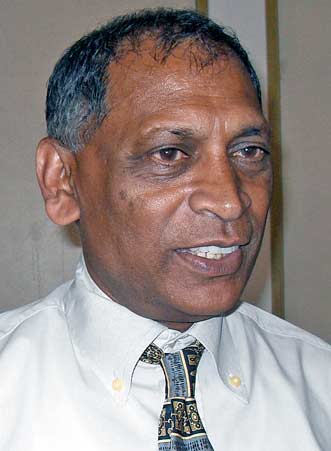
He attributed the increased suicide rate in Region 6 to the fact that residents in that agricultural region have greater access to pesticides, which is one of the leading materials used to commit suicide in the country. Of an estimated 150 to 200 persons who choose to end their lives annually about 48 of them come from that Region. He said that in Region Four (Demerara Central) about 50 to 60 persons commit suicide yearly but the impact is less as the population there is greater.
While the statistics up to the end of June show only 12 suicide deaths, a marked reduction, there were, however, 241 attempted suicides during this period. Figures reveal that within the last three years the number of suicides averaged 160-170, while in the previous three years the number was between 180–200. Dr Ramsammy concluded that there is therefore some encouraging sign that the enormous amount of work done in the past decade is leading to some reduction in the number of cases.
Dr. Ramsammy said that the Health Ministry has taken several courses of actions to reduce the occurrence of suicide in Guyana and noted that counselling is provided for persons who attempted to commit suicide in hospitals, clinics, and at homes. He advised that in most instances, whenever a person attempts suicide they do not want to die but in a moment of weakness the person caves in.
It is anticipated that in the coming years the Ministry will expand these sessions and link families with community groups, mainly the church.
Georgetown — Cinro Resources Inc., a Canadian exploration company dedicated to the exploration of Gold and polymetallic deposits in Guyana, has entered into its second phase of its exploration into its Potaro group of permits (hard rock mining).
Cinro Resources Inc., intends to further advance these properties to where a resource quality and quantity is defined, resulting in a technical report acceptable to Canadian standards.
Cinro has contracted ATLIS Geomatics Inc. (a Canadian aerial survey and mapping company) to provide digital topographic mapping of its Potaro project area. A recent company press release stated that ATLIS will be acquiring airborne Light Detection and Ranging (LiDAR) as well as new high resolution satellite imagery and producing detailed digital contour mapping and orthophoto of the 103 square km area. This data will provide valuable information for future planning, engineering and explorations.
ATLIS is partnered with GeoAir, S.A. de C.V., a Mexican aerial survey company to provide the aerial data acquisition services. GeoAir has extensive aerial survey experience in Central and South America. Due to extensive vegetation in the area the best technology for this project is airborne LiDAR to measure the terrain of the project area.
Cinro Resources is requiring these map services for their prolific Potaro project which is located approximately 220 kms south-west of Georgetown. This site comprises a total area of 10,378 Ha. Atlis was hoping to start the LiDAR Survey on or before September 15th, 2011 and have it completed within 15 days.
Cinro intends to make financial investments in its first two years of operations, with a combined larger investment over the next 10 years. These investment will be in the form of joint ventures or actual outright purchases of existing producing mines.
Cinro Chairman and Chief Executive Officer, Roy Singh, visited Guyana in early August and met with Prime Minister Samuel Hinds.
Mr Roy Singh said, "The people of Guyana are warm, friendly and hard working and it will be an asset for Cinro to hire directly from within the country – all that it can. We understand and expect that a number of persons will be non-nationals with skills, expertise, experience and contacts not available at the time in Guyana. We look to good working relationships between nationals and non-nationals to lead to learning from each other strength and steadily improving abilities."
Georgetown — The 540-kilometer fibre optic cable stretching from Brazil has reached Georgetown and connectivity is expected within two weeks.
Senior Engineer Walter Willis, who is overseeing the project on behalf of the government, told reporters earlier last week that currently workers are busy linking the sections and conducting the necessary tests to ensure continuity. One of the biggest concerns for the engineer and Government will be how to minimize the disruptions of connectivity, Kaieteur News (KN) reported. "Any disruptions will be a nightmare. I have conveyed this to Alexei Ramotar, who is managing the Project Execution Unit (PEU)," Willis said.
According to KN, Willis has plenty reasons to be fearful as the fibre optic cable is crossing rivers, going underground and being strung on poles. Laying of the cable, which have come in 10-kilometer segments, started last year and was faced with many challenges. Three contractors were hired initially and then two more retained to speed up the work.
With heavy rains in Region Nine during the mid-year period, work also suffered because of flooding along the Lethem trail.
There was one deliberate cut and at least four accidental ones while the laying was in progress but all of these have since been corrected.
Willis said the cable laying has been done in phases: from Takutu Bridge, Lethem to Annai; from Annai to Kurupukari; from Kurupukari to Mabura and from Mabura to Wisroc Junction. From being underground up to Wisroc Junction, it was then partially suspended to the Linden Turnoff before being placed underground again up to Kuru Kururu. From there, it has been strung on posts to the city.
The PEU has already acquired equipment, similar to that of the Guyana Telephone and Telegraph Company, to quickly identify problem areas along the lines. The project, part of a larger plan to speed internet access across Guyana, came shortly after GT&T landed a US$60M fibre optic cable from Suriname, KN noted.
The Brazil cable will see improved connectivity between government offices, easier access to citizens to download forms, passport applications and other critical information. Government will be creating hotspots and cheaper internet connections from this cable. Willis said the cable is crucial to a government's project to place 90,000 laptops in the hands of poor families across Guyana.
Georgetown — The government used its parliamentary majority to pass legislation for the Access to Information Bill when the National Assembly met last Thursday in the absence of the opposition who are boycotting parliament.
The Bill, which will have to be assented to by the President before it becomes law, places the release of information solely in the hands of a Commissioner of Information. In response to criticisms about this, Government Parliamentarians argued that the Commissioner would serve as a conduit through which information would be released.
Prime Minister Samuel Hinds brushing aside criticism that the bill should have been named "Freedom of Information" Bill, said what is important is that the legislation sets out a practical regime for access to information. He stated that "The Bill is a Freedom of Information bill in practice."
The Bill, which was tabled in the National Assembly on June 17, was sent to a Special Select Committee for further discussions and to allow for public input. However with the opposition boycotting parliament the Committee did not benefit from the input of the Parliamentary opposition. Prime Minister Hinds noted that while the Bill was sent to a Special Select Committee, no changes in principle or intent were made and that whatever amendments were made, were to clarify explanations, remove ambiguities, and correct some typographic errors and layout issues.
The government moved ahead with its Access to Information Bill in favour of the Freedom of Information (FOI) Bill tabled by the Alliance for Change (AFC). Hinds said that when the Act comes into play, it would establish systems all across the government that would allow for consistent ways of filing and retaining documents and retrieval of such documents.
The opposition is holding out on its position not to attend sittings of the House during this period when Parliament was called out of recess. The Parliamentary recess should have commenced on August 10 and extended until October 10, according to the Parliamentary Standing Orders but the government had moved to the House to pass a motion suspending the recess.
Georgetown — "I don't want to go into details of the report but it had nothing to do with the airport being too dark, which I have seen, the runway being too short, that there were rainy conditions and the visibility was poor. Rather Guyana's safety record speaks for itself over the years." This is what President Bharrat Jagdeo told a Trinidad television station two Tuesdays ago with regard to the Caribbean Airline (CAL) crash which occurred at the Cheddi Jagan International Airport (CJIA) on July 30 last. Jagdeo said that a preliminary report may suggest other reasons for the crash-landing.
Jagdeo, who was in Trinidad for an Economic and Trade Cooperation Forum was reported as saying, "I have heard in some sections of the media that there are safety issues at our airport. Planes have been landing there for the past 70 years and we have never had any such situation," adding that "bigger planes have landed there; the L-1011 has landed in Guyana frequently and safely."
According to the CMC report, Jagdeo said that visibility at the airport at the time of the incident was well beyond what was necessary for pilots to safely land an aircraft.
President Jagdeo said that the preliminary report would be made public shortly and he would not as a politician release the preliminary report but would rather leave that to the technical people.